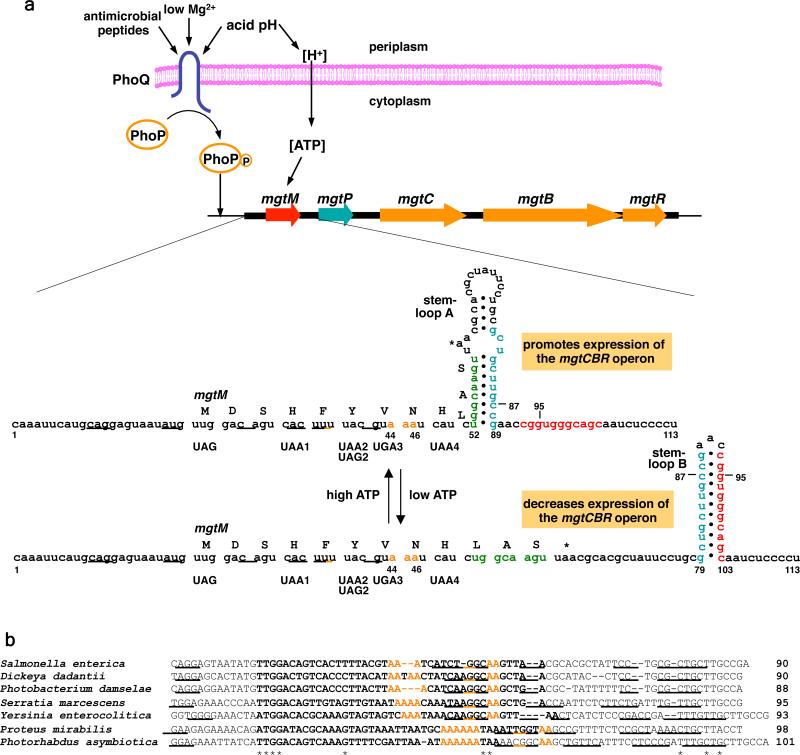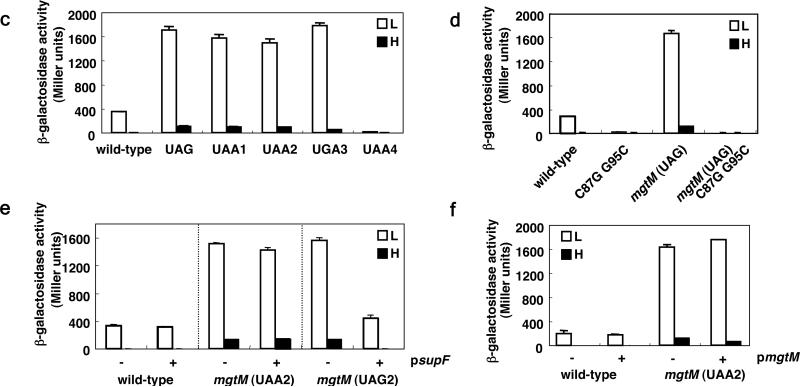Figure 4. Regulation of the Salmonella mgtCBR virulence operon by the PhoP/PhoQ system and mgtCBR leader region.
a, The sensor PhoQ responds to extracytoplasmic low Mg2+, acid pH and antimicrobial peptides by promoting phosphorylation of the PhoP protein, which binds to the mgtCBR promoter resulting in transcription initiation. Acidic pH also produces a proton gradient across the inner membrane resulting higher intracellular ATP levels. Intracellular ATP levels control transcription elongation into the mgtCBR coding regions by affecting the coupling/uncoupling of transcription of the mgtCBR leader and translation of the short ORF mgtM, which affects the formation of alternative stem-loops A versus B. The mgtM RBS is underlined. Positions and sequences of stop codon mutations or nucleotide substitutions in the strains used in the experiments presented in (c) and (d) are indicated and denoted below the mgtM sequence. b, Conservation of A nucleotides in mgtM relative to stem-loop structures in the mgtC leader. Alignment of the nucleotide sequences corresponding to mgtM from the indicated species. Sequences in bold correspond to mgtM. The mgtM RBSs are underlined. Asterisks correspond to nucleotides conserved in all listed species. Conserved A nucleotides are colored in orange and sequences with a potential to adopt stem-loop structures are underlined. c, β-galactosidase activity (Miller units) produced by Salmonella with a chromosomal mgtC-lac fusion (EG9527) and isogenic derivatives with mutation of the start codon (EG19269) or with stop codons at different positions (EG19285, EG19289, EG19293 and EG19298) in mgtM. Bacteria were grown in N-minimal media containing low (L; 10 μM) or high (H; 10 mM) Mg2+ for 4 h. d, β-galactosidase activity (Miller units) produced by Salmonella with a chromosomal mgtC-lac fusion (EL92) and isogenic derivatives with C87→G and G95→C substitution (EL96) or mutation of the start codon in mgtM (EL97) or both (EL98). Bacteria were grown as described in (c). Shown in (c) and (d) are the mean and SD from three independent experiments. e, β-galactosidase activity produced by Salmonella with a chromosomal mgtC-lac fusion harboring either plasmid psupF or the empty vector pUH21-2lacIq (EL86, EL87) and isogenic derivatives with an amber stop codon (EL90, EL91) or ochre stop codon (EL88, EL89) at position 39-41 of mgtM. Bacteria were grown as described above except in the presence of ampicillin and 0.2 mM IPTG. f, β-galactosidase activity produced by Salmonella with a chromosomal mgtC-lac fusion (EG9527) or a isogenic strain with a stop codon at position 39-41 in mgtM (EG19289) harboring either the vector or plasmid pmgtM. Bacteria were grown as described except in the presence of ampicillin and 0.1 mM IPTG. Shown in (e) and (f) are the mean and SD from two independent experiments.


